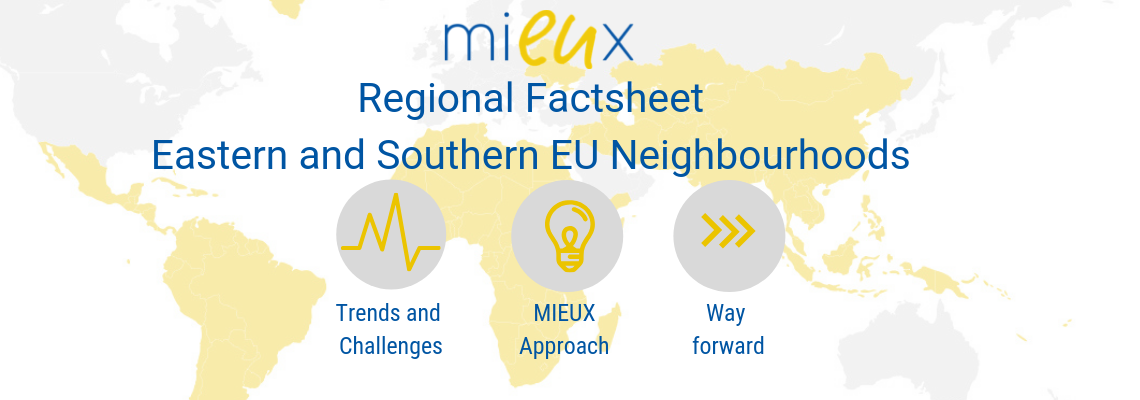MIEUX and the EU Neighbourhood
Today, the MIgration EU eXpertise Initiative publishes a new Regional Factsheet that describes its experiences working across the Eastern and Southern EU Neighbourhoods since 2009. Present in the two sub-regions since its inception, MIEUX’s interventions have provided capacity building activities for institutions on subjects such as communication, data management, irregular migration and trafficking, and labour migration, among others. Comprising 16 countries with very diverse characteristics, the Neighbourhoods share a close relationship with the EU, based not only on shared borders but also on increasingly shared objectives and standards for the governance of migration as expressed in the EU Neighbourhood Policy (ENP). Developed in 2004 and revised in 2015 to better address migration and mobility, the ENP supports asylum seekers, seeks to address the root causes of migration and displacement, improves cooperation on return, readmission and reintegration, identifies gaps in skills to facilitate mutually-beneficial labour migration, as well as promotes student and academic mobility. [Download the Regional Factsheet]
Drivers of migration and areas for improvement
Two main drivers of migration can be identified in the European Neighbourhood: the search for better economic and professional opportunities and forced migration. The Eastern Neighbourhood is the origin of important emigration flows that have the EU and most importantly the Russian Federation as its primary destinations. Civil conflict in Ukraine has reinforced this trend with renewed flows of forced migration. In the Southern Neighbourhood, North African countries have traditionally been countries of emigration towards European countries and the Gulf States. Maghreb countries are also an important transit area for flows from Sub-Saharan Africa towards Europe, and more recently transit and destination for Libyan and Syrian asylum seekers. In Middle Eastern countries, forced displacement has been a major issue in recent years. At the end of 2016, countries in the Middle East hosted over 45% of all refugees globally, with Jordan and Lebanon playing a crucial role in receiving refugees from Syria.
Several areas of migration governance and management deserve special attention for the institutions involved, including but not limited to, countering irregular migration and managing borders; countering trafficking in accordance with international standards and practices; developing and managing data on migration; harmonising migration policies in line with EU standards; and fostering the contribution of diaspora groups to national development. [Download the Regional Factsheet]
MIEUX's interventions
Since 2009, MIEUX’s 14 interventions have supported the advancement of a closer relationship in matters of migration and mobility between the EU and its partners in the Eastern and Southern Neighbourhoods. Capacity building requests have sought very diverse objectives, from improving communication between border police and the general public in Moldova to formulating a Protocol for better first-line assistance to Victims of Trafficking in Jordan. [See more examples in the Regional Factsheet]
The way forward
The Eastern and Southern Neighbourhoods are very diverse in their approach and needs to migration. Nevertheless, according to MIEUX’s experience in the region, a series of avenues would be worth exploring to enhance migration governance and management in these sub-regions.
Further address mixed migration flows, especially in the context of the Southern Mediterranean area, public authorities dealing with migrants should address the complexity and multi-dimensionality of these inflows, both in order to guarantee the respect and protection of human rights and to support the effectiveness of migration management responses.
Strengthen data collection and data sharing on migration. One key obstacle in building evidence-based migration policies is the unavailability of data on migration. Equally important, the sharing of data between governmental institutions is the next logical step in order to produce a comprehensive picture of human mobility at local, national and regional levels.
Foster the harmonisation of national laws and policies with international standards and legal instruments to protect migrant workers in line with the provisions set out in the International Labour Organization’ s (ILO) Conventions to support a fairer and human rights-based governance of labour migration. See an example from Belarus.
Enhance cooperation between the EU, EU MS and EU Neighbourhood countries on diaspora engagement in order to capitalise on the potential of diaspora members for national development. For example, stronger partnerships between countries of origin and destination in the EU could improve the mapping of diaspora communities.
Further support a peer-to-peer approach to allow exchange on migration issues between the EU, EU Member States and EU Neighbourhood countries. As MIEUX has demonstrated, a peer-to-peer approach to capacity building is beneficial, as it allows to support partner countries in their efforts to strengthen their migration governance frameworks as well as building trust and mutual learning to enable closer partnerships. This approach has allowed MIEUX to foster enhanced migration governance and partnerships between the EU and EU Neighbourhood countries for the last decade.
[Download the Regional Factsheet]
Find out more



